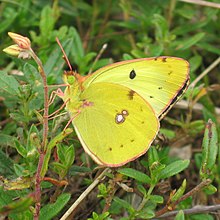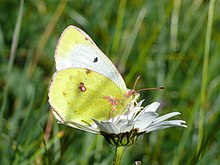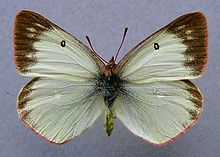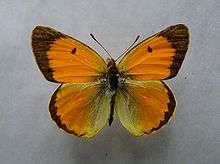Colias
| Colias | ||||||||||||
|---|---|---|---|---|---|---|---|---|---|---|---|---|

Golden eight ( Colias hyale ) |
||||||||||||
| Systematics | ||||||||||||
|
||||||||||||
| Scientific name | ||||||||||||
| Colias | ||||||||||||
| Fabricius , 1807 |


Colias is a genus mostly medium-sized butterflies ( butterflies ) of the subfamily of the yellow pieces (Coli Adinae) in the family of Whites (Pieridae). The genus includes about 80 species and is mainly distributed in Central Asia .
features
The moths are mostly medium-sized, some species are among the larger moths. The basic colors are yellow, orange and sometimes white or greenish yellow. They have a dark band on the edge of the wing, which is generally more developed in females. The antennae are rather short with a gradually thickened but distinct bulb. The veining of the wings is characteristic of the complete lack of precostalis, which they only have in common with the outwardly very different genus Terias . The tip of the forewings is rounded. The fore wing has four subcostal branches, the first of which branches off well before the end of the middle cell. The superior radial arises from the subcostal, so the superior discocellular is absent.
The males of many species have a sharp, small disc of scented scales on the front edge of the upper side of the hind wing as a secondary sexual distinction . The sexual dimorphism is well developed in some species, as is the dimorphism of the female forms, which often appear in a pale (f. Alba ) and a bright yellow or orange form. A seasonal dimorphism with a spring and summer form exists in some two-brood species such as Colias philodice .
There is a correlation between the extent of the black wing areas and the altitude and thus the temperature at which the animals occur. The colder the region, the more pronounced the dark edges.
The hind wings have a central prominent spot, which in some species has a reddish edge on the underside. The sexes are usually easy to distinguish due to the sexual dichroism of the genus, but the adults of the individual species are sometimes difficult or impossible to distinguish. This applies, for example, to the southern hay moth ( C. alfacariensis ) and golden eight ( C. hyale ) species that occur in Central Europe , which can only be distinguished in the advanced larval stage.
The spindle-shaped, horizontally fluted eggs are attached to plants with a disc-shaped foot. The caterpillars have a small head and only single, short hairs and no spines. They are usually green in color and some have longitudinal stripes.
distribution
The genus has its main range in Asia with at least 45 species, with a particularly large number in Central Asia. There are 12 species in Europe and 14 in North America. Eight species are found in the mountains of tropical Central and South America and in the plains of the southern part of South America. Only four species occur in Africa and are completely absent in Southeast Asia and Australia . The Colias species occur in Europe to Norway and in Asia to Japan , in Africa to the Cape and in North and South America from Canada to Patagonia .
habitat
The animals are almost exclusively restricted to areas with a temperate climate and are absent in the hot tropical zones. Some species can be found in cool zones, such as Colias meadii in the high alpine area of the Rocky Mountains up to 3600 meters above sea level. NN , which thus has one of the highest habitats among butterflies. Colias hecla achieved in Greenland the 75th latitude and in Tierra del Fuego comes with Colias ponteni one of the largest and most beautiful species.
Most species are tied to a specific habitat, only a few species are widespread and live in numerous habitats. Alpine zones and grass-covered tundras are typical , only a few live in bogs surrounded by forests, such as the raised bog yellowfling ( Colias palaeno ) and Colias scudderi , or on herbaceous areas such as Colias eurytheme . Only a few live in low altitudes ( Colias pelidne ).
Way of life
Some species occur in two generations, but arguably most in just one generation. The winter in the temperate and cool zones takes place as a caterpillar.
butterfly
The butterflies are quick and persistent fliers. The larger species usually fly a few meters above the ground. All moths of the genus Colias are lateral absorption suns and therefore close their wings immediately after landing and place one underside of the wing perpendicular to the sun. Depending on the position of the sun, they can almost be on the ground.
The males of many species form pheromones in glands under the scent scales to attract females. The density of scent scales is twice as high as that of normal scales in some species . So that the pheromones are not blown away by wing flaps and wasted, the scent scales sit on the upper sides of the hind wings at a point where the front and rear wings overlap. For example, the polar species Colias hecla and Colias nastes do not produce pheromones. In addition to the pheromones, the females can partly recognize the males of their species by the pattern of the wings in the ultraviolet range. The males of Colias eurytheme have to reflect light in the UV range so that they can mate, while this is not the case with the closely related species Colias philodice , which together form hybrids in places.
About a day or two after mating, the females begin to lay many eggs for several weeks. If they live that long, egg production will decline afterwards. They can lay up to 700 eggs, although there are on average significantly fewer in the wild due to the shorter life expectancy.
The females of Colias philodice can recognize the peculiarities of a plant species and then mostly lay off this species, while other females in the same area specialize in another species.
The Colias males often accumulate in humid places and suck the water sodium - ions on. If a male has settled in a damp place, others will notice and within a short time a large number can gather. They are even briefly attracted by dead butterflies on the ground. Fresh male moths have a sodium concentration about twice as high as the females. This decreases steadily with increasing age in the males, while it is quite stable in the females, although they need sodium for the eggs. But they get a lot of sodium from the males through the spermatophore , which compensates for the loss through the eggs.
Caterpillars
The food plants of the caterpillars are primarily butterflies (Faboideae), especially of the genera tragacanth ( Astragalus ) and clover ( Trifolium ). Some of the species that live in forests feed on deciduous trees such as willows and on blueberries ( Vaccinium ). Most species are food specialists and are tied to one or only a few species.
In some alpine species the caterpillars overwinter twice, first as a young and then as an almost fully developed caterpillar. At 20 to 29 ° C, the caterpillars prefer cooler temperatures than the later adults. They pupate as a falling doll .
genetics
The pale form (f. Alba ) of the females occurs in all Colias and related species, which shows that this characteristic was already present in the common ancestor of the species and was retained in all species developed from it. This trait is inherited dominantly. The white females prefer the same temperatures as the normal form, but they develop faster, contain more fat and lay larger eggs because they do not need nitrogen for the production of orange pigments. This gives them an advantage, especially in colder regions, over the normal form preferred by the males.
The ability to reflect ultraviolet light is gender-specific and is inherited via the two X chromosomes in males. The females do not reflect ultraviolet light, although they have an X chromosome in addition to a Y.
The day length (photoperiod) controls whether genes are activated that are responsible for the spring or summer form of the moth.
Harmful effect
Colias eurytheme and Colias philodice canoccur as pestson clover and alfalfa fields ( Medicago sativa )in North America.
etymology
Colias is an epithet of the goddess Aphrodite (goddess of love, beauty and sensual desire).
Systematics
Of the approximately 80 species of the genus Colias , eight occur in German-speaking countries (A, CH, D). All over Europe they are represented by 12 species.
Species in German-speaking countries and Europe
The postillon ( Colias croceus ) is a widespread migratory butterfly that often flies from southern Europe to central Europe. Also widespread are the golden eight ( Colias hyale ), which occurs on meadow orchards , wet meadows and poor and dry grassland, and the southern hay butterfly ( Colias alfacariensis ), which can be found on lime-rich, dry grassland and in dry bushes and forest fringes. The caterpillar of the raised bog yellowblings ( Colias palaeno ) is bound to bog berries ( Vaccinium uliginosum ), which in Germany, Austria and Switzerland only grows in raised bogs . The Alpine yellow fling ( Colias phicomone ) occurs only on alpine meadows in European high mountains from 900 to 3000 meters above sea level. The steppe species Colias erate , light orange green hay butterflies ( Colias chrysotheme ) and Regensburg yellow fling ( Colias myrmidone ) occur only in Austria, whereby the latter has its western limit in the German border area with Austria in the Jura near Regensburg.
Other species in Europe are Colias aurorina in the mountains of Greece , Colias caucasica in the western Caucasus and the three arctic species Colias hecla ssp. sulitelma , Colias tyche and Colias werdandi in arctic Scandinavia .
species
The North American species cesonia and eurydice are no longer assigned to the genus Colias , but to the genus Zerene , which consists only of these two species . The hybrid of the greenish C. nastes with the orange C. hecla is called boothii .
- Colias adelaidae Verhulst , 1991
- Colias aegidii Verhulst , 1990, Asia
- Colias aias Fruhstorfer , 1903, Asia
- Colias Alexandra Edwards , 1863 North America
- Colias alfacariensis ( Staudinger , 1871) Europe, Asia
- Colias alpherakii Staudinger , 1882, Asia
- Colias alta Staudinger , 1886, Asia
- Colias arida Alphéraky , 1889, Asia
- Colias aurorina ( Herrich-Schäffer , 1850) Europe, Asia
- Colias behrii Edwards , 1866, North America
- Colias berylla Fawcett , 1904
- Colias canadensis Ferris , 1982, North America
- Colias caucasica ( Staudinger , 1871) Europe, Asia
- Colias chlorocoma Christoph , 1888, Asia
- Colias Christina Edwards , 1863, North America
- Colias christophi Grum-Grshimailo , 1885, Asia
- Colias chrysotheme ( Esper , 1781), Europe, Asia
- Colias cocandica Erschoff , 1874, Asia
- Colias croceus ( Geoffroy , 1785) Africa, Asia, Europe
- Colias dimera Doubleday , 1847, South America
- Colias diva Grum-Grshimailo , 1891, Asia
- Colias dubia Fawcett , 1906, Asia
- Colias electo ( Linnaeus , 1763), Africa, Asia
- Colias eogene C. & R. Felder, [1865], Asia
- Colias erate ( Esper , 1805) Africa, Asia, Europe
- Colias schoffii Alphéraky , 1881, Asia
- Colias eurytheme Boisduval , 1852, North America, Central America
- Colias euxanthe C. & R. Felder , 1865, South America
- Colias felderi Grum-Grshimailo , 1891, Asia
- Colias fieldii Ménétriés , 1855, Asia
- Colias flaveola Blanchard , 1852, South America
- Colias gigantea Strecker , 1900, North America
- Colias grumi Alpheraky
- Colias harfordii H. Edwards , 1877, North America
- Colias hecla ( Lefèbvre , 1836) Asia, North America
- Colias heos ( autumn , 1792), Asia
- Colias hyale ( Linnaeus , 1758) Asia, Europe
- Colias hyperborea Grum-Grshimailo , 1899, Asia
- Colias interior Scudder , 1862, North America
- Colias lada Grum-Grshimailo , 1888, Asia
- Colias ladakensis Fields & Fields , 1865, Asia
- Colias leechi Grum-Grshimailio , 1893
- Colias lesbia ( Fabricius , 1775), South America
- Colias marcopolo Grum-Grshimailo , 1888, Asia
- Colias marnoana Rogenhofer , 1884, Africa
- Colias meadii Edwards , 1871, North America, Asia
- Colias minisni Bean , 1895, North America
- Colias montium Oberthür , 1886, Asia
- Colias mossi Rothschild , 1913
- Colias myrmidone ( Esper , 1781) Europe
- Colias nastes Boisduval , 1832, North America, Asia
- Colias nebulosa Oberthür , 1894, Asia
- Colias nilagiriensis C. & R. Felder , 1859, Asia
- Colias nina Fawcett , 1904
- Colias occidentalis Scudder , 1862, North America
- Colias palaeno ( Linnaeus , 1761) Asia, Europe, North America
- Colias pelidne Boisduval & Le Conte , [1829], North America
- Colias phicomone ( Esper , 1777), Europe
- Colias Philodice Godart , 1819, North America Central America
- Colias poliographus Motschulsky , 1860, Asia
- Colias ponteni Wallengren , 1860, South America
- Colias regia Grum-Grshimailo , 1887, Asia
- Colias romanovi Grum-Grshimailo , 1885, Asia
- Colias sagartia Lederer , 1869, Asia
- Colias scudderii Reakirt , 1865, North America
- Colias shahfuladi Clench & Shoumatoff , 1956, Asia
- Colias sieversi Grum-Grshimailo , 1887, Asia
- Colias sifanica Grum-Grshimailo , 1891, Asia
- Colias staudingeri Alphéraky , 1881, Asia
- Colias stoliczkana Moore , 1882, Asia
- Colias tamerlana Staudinger , 1897, Asia
- Colias thisoa Ménétriés , 1832, Asia
- Colias thrasibulus Fruhstorfer , 1908
- Colias tibetana Riley , 1922, Asia
- Colias tyche ( Böber , 1812) Asia, Europe, North America
- Colias vauthierii Guérin-Méneville , [1830], South America
- Colias wanda Grum-Grshimailo , Asia
- Colias Weberbaueri Beach , 1912
- Colias werdandi Zetterstedt , 1840, Europe
- Colias wiskotti Staudinger , 1882, Asia
swell
- Scott, James A .: The butterflies of North America . Stanford University Press, Stanford, California 1986, ISBN 0-8047-1205-0 , pp. 259 f . (632 pages).
Individual evidence
- ^ The University of Arizona College of Agriculture and Life Sciences and The University of Arizona Library: Colias. In: Tree of Life Web Project. September 17, 2008, accessed January 30, 2009 .
- ^ A b c W. J. Holland, Butterfly Guide , Doubleday, Page & Company, 1920
- ↑ a b c Seitz, Adalbert: Die Großschmetterlinge des Palaearktischen Faunengebietes, Die palaearktischen Tagfalter , 1909, 379 pages, with 89 colored plates, Verlag Alfred Kernen, Stuttgart
- ↑ a b Scott, page 81
- ↑ Species complex Colias hyale (Linnaeus, 1758) and C. alfacariensis Ribbe, 1905. Lepiforum eV, accessed on May 15, 2007 .
- ^ A b Günter Ebert, Erwin Rennwald: The Butterflies of Baden-Württemberg Volume 1, Tagfalter I (Knight Butterflies (Papilionidae), Weißlinge (Pieridae), Edelfalter (Nymphalidae)), Ulmer Verlag Stuttgart 1993. ISBN 3-8001-3451-9
- ^ Scott, 101
- ^ Scott, p. 106
- ↑ sulphurs (Adinae Coli). Opler, Paul A., Harry Pavulaan, Ray E. Stanford, Michael Pogue, coordinators. 2006. Butterflies and Moths of North America. Bozeman, MT: Mountain Prairie Information Node, accessed May 15, 2007 .
- ↑ Scott, page 52ff
- ^ Scott, 62
- ^ Scott, 68
- ^ Scott, p. 27
- ^ Scott, p. 42
- ^ Scott, pp. 79 and 196f
- ^ Scott, 78
- ^ Scott, 110
- ^ Arnold Spuler: The butterflies of Europe . tape 1 . E. Schweitzerbartsche Verlagbuchhandlung, Stuttgart 1908, p. 9 .
- ↑ Pieridae. Lepiforum eV, accessed on May 15, 2007 .
- ↑ Colias. Fauna Europaea, accessed May 15, 2007 .
- ↑ LG Higgins, ND Riley: The butterflies of Europe and Northwest Africa . Verlag Paul Parey, Hamburg and Berlin 1978, ISBN 3-490-01918-0 , p. 49 ff .
- ↑ Grieshuber, J. & Lamas M., G. 2007: A synonymic list of the genus Colias Fabricius, 1807 . Mitt. Munch. Ent. Ges. 97, 131-171. quoted in Tree of Life Web Project
- ↑ Markku Savela - Lepidoptera and some other life forms - Colias
















